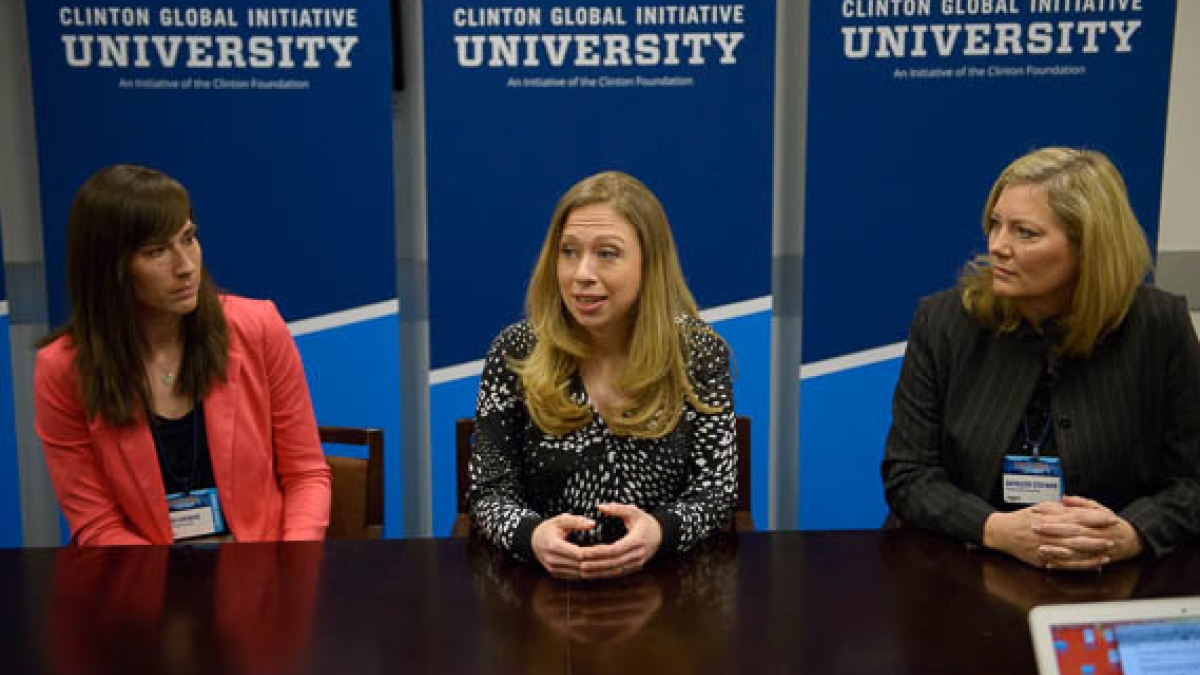Q&A with Chelsea Clinton at CGI U

The following excerpt is from a question and answer session held for ASU media by Clinton Foundation Vice Chairman Chelsea Clinton on Saturday, March 22 at the Clinton Global Initiative University at Arizona State University. ASU students and CGI U commitment makers Laura Chenier and Kathleen Stefanik joined Clinton for the session.
Q: A lot of students who have good ideas are intimidated to take steps that will take that idea forward. How would you encourage them?
Chelsea Clinton: We think that CGI U is the best antidote to that hesitation. As a community of more than 65,000 students who really have taken that first step, and have raised their hands, not only wanting to make a difference, but outlining steps on how to make that difference.
So often, people don’t do something because of a failure of imagination. They are unable to imagine that they themselves can make a difference. One of the things that we try to help our CGI U commitment makers with are to think about the small steps that will add up to make a big difference. Helping people to understand what that first step could be makes that first step so much more likely to be achieved, which then makes the second and the third steps more likely to be taken.
Individuals can also choose to not start something of their own, but support other causes. There are many different ways to contribute in the world today. We have more options and platforms than ever before. For people who really do want to make a specific difference, who are outraged by something and want to attack that, or really inspired by something and want to pursue that, I hope they can come to CGI U or visit online, or see how they can engage around the world through different platforms to make a difference.
Q: Could you share any of your favorite success stories related to CGI U?
Chelsea Clinton: One that comes to mind is Triple Thread by a student Kyle Lloyd McCollom out of Vanderbilt who committed to providing a pathway to employment to 10 former offenders by starting a silk screen printing T-shirt business targeting potential customers from Vanderbilt, and ended up employing more people.
It was a focus area that too often exists in the shadows and that hadn’t received a lot of attention at CGI U. Kyle came back to CGI U in 2010, and again in 2012. Due to his willingness to invest back in CGI U – because he was aware how much the conference had benefitted him – we saw far more commitments targeting the juvenile and adult prison systems emerge in 2013. It was really affirming because Kyle’s example showed that by continuing to highlight not just challenges, but also solutions, we could pull things out of the shadows.
Additionally, young people, like most participants at CGI U, are so much less likely to be burdened with stigma or live with fear to take on something that has caused discomfort for a long time. Kyle is the vanguard but certainly not alone at CGI U.
Q: How do you think the change-making movement defines the past, present and future of education?
Chelsea Clinton: I think that how it defines the past is how we understand history in a more democratic way. For example, in Washington, D.C., there are more than 270 statues, and only nine are of women. We had many more women change-makers in the past than the nine represented. As we democratize the education platform, more people can talk about what’s important to more of us and have a more comprehensive view of our history.
In the present, we have discussed taking that comprehensive view already. In having options and platforms to make a difference, not only more people are engaged and influencing what’s happening today in the public, private and social sectors, but more people are beginning to feel empowered, despite skepticism, to have an impact.
I hope that in the future, we will see more of that. I hope it will influence our politics and markets in ways we can’t imagine. Because more people feel that they not only have the opportunity, but the obligation to participate.
Laura Chenier: A big part of that is access to information through social media and the Internet. Being more aware of what the issues are and being able to partner with and get information from to understand the steps to take.
Chelsea Clinton: Knowing what works and what doesn’t also helps. Before the onset of the Internet, it was laborious to know what works on the opposite side of the world to see how it can apply in a similar area somewhere else. Easily available information and ability to exchange knowledge helps increase the velocity of change.
Kathleen Stefanik: I want to add an observation. Being an older student, I’ve seen that a lot of older individuals, people who are my age, lose the drive to change the world as soon as they graduate. It’s everyone’s responsibility, and there’s something everyone can do to change the world.
Laura Chenier is an ASU graduate student majoring in audiology. Her CGI U commitment, SHOW Audiology Clinic, hopes to assist in minimizing health disparities, especially related to hearing loss, among at risk populations within Maricopa County by providing comprehensive, high quality care.
Kathleen Stefanik is an ASU senior majoring in psychology. She was able to embark on her own journey of higher education after securing the educational future of her three children. Her CGI U commitment, GAIA International, hopes to help farmers in rural Peru to increase crop production cost-effectively by using an ancient method of soil improvement called Terra Preta.